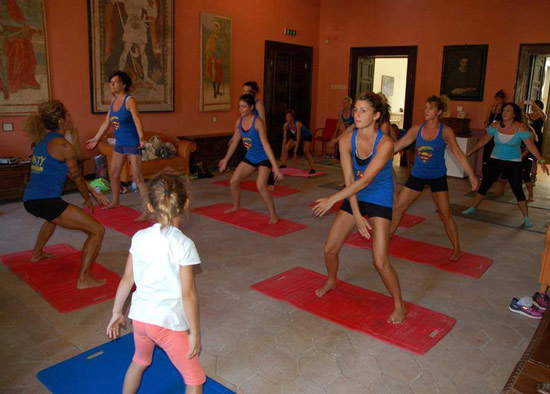It’s true: “raising awareness about the importance of motor activity” is probably the last thing on the minds of serial buffet assailants at exhibition openings, figures to whom anyone who frequents the art and museum environment is surely accustomed. It must be said, however, in their defense, that often the overflowing trays of greasy and juicy foodstuffs do not take on the appearance of “snacking on zero-mile seasonal fruit,” but rather that of inviting as much as annihilating lipid and carbohydrate bombs that drive away all good intentions about diet, proper nutrition and physical activity.
However, we are perfectly aware that physical activity is extremely important and that there is a need to raise awareness of an issue to which many people, art enthusiasts and otherwise, pay very little attention. The problem is that there are places and ways to conduct campaigns on the topic: doing Pilates and yoga inside a museum is perhaps not the best way to achieve the goal. Not least because it is far from a novel idea, as the promoters of"Musei in Forma,“ or ”the event of the Terre & Musei dell’Umbria circuit dedicated to the well-being of body and mind,“ would have us believe, which translated means: activities that typically take place inside gyms will be moved, for a handful of weekends between September and October, inside the museums of a number of Umbrian towns (Amelia, Bettona, Bevagna, Cannara, Deruta, Marsciano, Montefalco, Montone, Spello, Trevi, Umbertide). We said it is anything but an ”unprecedented contamination," as the event’s poster proudly and pompously declaims: with Sport Week in Santa Maria della Scala in Siena (an event that caused quite a bit of discussion, and obviously not in a good way) we thought we had already hit rock bottom, but we had not been original enough to foresee not only that there would still be people who would consider museum halls suitable places to host gymnastic practices, but also that the said people would take care to structure it into an event complete with a program, obligatory hashtags, a cartoonish flyer à la page and a 199 call center to reserve one’s place at the relaxation techniques class or judo demonstration.
 |
| An event from the “Museums in Shape” review, from the Terre e Musei dell’Umbria Facebook page. |
Certainly, if nothing else compared to Santa Maria della Scala, we have made some steps forward: zumba and martial arts have been replaced by more tranquil “postural training,” “flexibility” and “gentle gymnastics” classes (participants will probably sweat less, reducing the risk of altering the microclimate of the halls, and the works will not be in danger of receiving flying kicks from someone a little too engrossed in the kickboxing class). And it should be emphasized that, at least, the events are open to all (so a thousand times better the judo demonstration in front of Luca Signorelli than thecafonal bachelor party for a few guests at the Pitti Palace). But it is still unclear what the goal of “Museums in Shape” is. “To raise awareness about the importance of motor activity”? From the photos, it seems that the participants are fully fit, accustomed to physical activity and therefore not at all in need of being sensitized. Besides, for what bizarre reason does the awareness-raising have to take place within the halls of a museum? Or, since the slogan reads “I am fit. I’m going to the museum” (thus seemingly at odds with the stated objective: if I’m already fit, why do I need to be sensitized?), is the purpose of the initiative to bring the gymnasium people into museums? But are we sure that the correct method of achieving that goal is to allow “flexibility” enthusiasts to perform their favorite activity in front of an altarpiece?
The writer is light years away from the idea of a congealed museum, folded in on itself, self-referential, unwilling to rethink itself in a new and open perspective to the world. But he is also little attracted to the idea that the museum can take on the guise of a container within which the works become dumb trappings, or at best “splendid setting” (as per the overused expression used in the “Musei in Forma” poster) for events that have little to do with the purpose of the museum (yes, we know that culture and body care are closely related: but zomping around inside an art gallery does not seem to us the best way to extrude the connection). Excesses should be avoided, but there are still few museums that have the foresight, intelligence, and elegance to understand that the best way to experience a museum is to find a proper middle ground between the janitor who apostrophizes you rudely if he catches you sitting disheveled while contemplating a Baroque sculpture, and the expanse of stretching mats under the fragments of fourteenth-century frescoes. Otherwise, if all things are permitted, it wouldn’t be a bad idea if we agreed as of now to organize a group dance session to the tunes of Betobahia ’s hits on tour in Italian museums. Those who appreciate the genre will surely like it.
Warning: the translation into English of the original Italian article was created using automatic tools. We undertake to review all articles, but we do not guarantee the total absence of inaccuracies in the translation due to the program. You can find the original by clicking on the ITA button. If you find any mistake,please contact us.